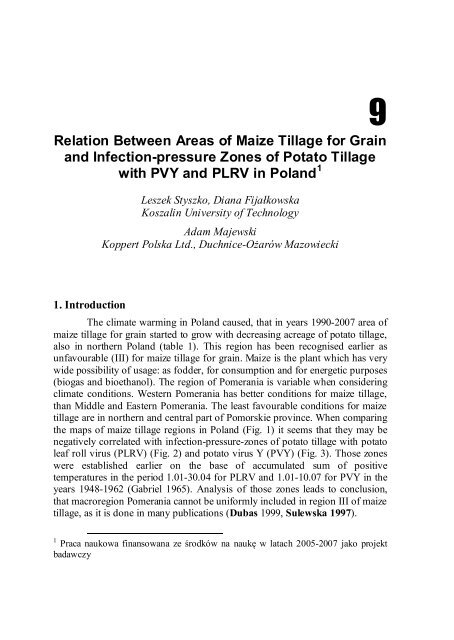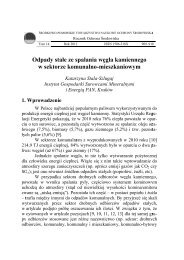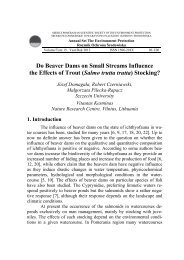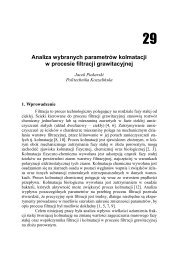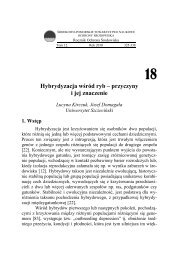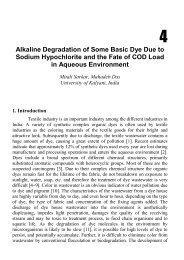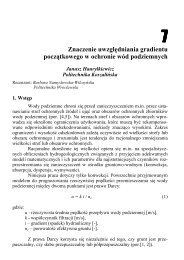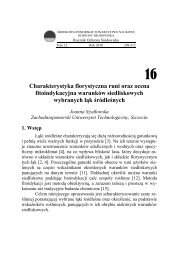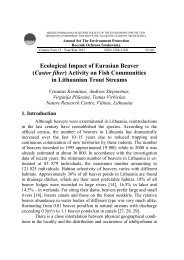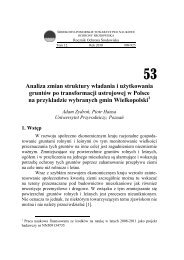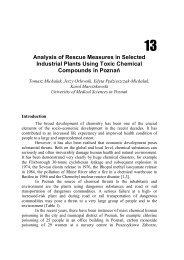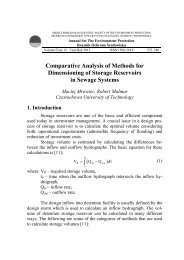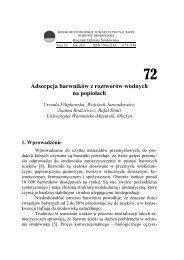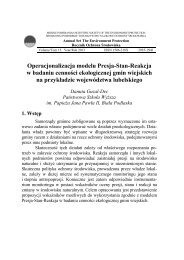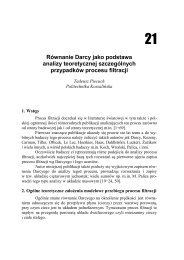Leszek Styszko, Diana Fijałkowska, Adam Majewski - Rocznik ...
Leszek Styszko, Diana Fijałkowska, Adam Majewski - Rocznik ...
Leszek Styszko, Diana Fijałkowska, Adam Majewski - Rocznik ...
You also want an ePaper? Increase the reach of your titles
YUMPU automatically turns print PDFs into web optimized ePapers that Google loves.
9<br />
Relation Between Areas of Maize Tillage for Grain<br />
and Infection-pressure Zones of Potato Tillage<br />
with PVY and PLRV in Poland 1<br />
1. Introduction<br />
<strong>Leszek</strong> <strong>Styszko</strong>, <strong>Diana</strong> <strong>Fijałkowska</strong><br />
Koszalin University of Technology<br />
<strong>Adam</strong> <strong>Majewski</strong><br />
Koppert Polska Ltd., Duchnice-Ożarów Mazowiecki<br />
The climate warming in Poland caused, that in years 1990-2007 area of<br />
maize tillage for grain started to grow with decreasing acreage of potato tillage,<br />
also in northern Poland (table 1). This region has been recognised earlier as<br />
unfavourable (III) for maize tillage for grain. Maize is the plant which has very<br />
wide possibility of usage: as fodder, for consumption and for energetic purposes<br />
(biogas and bioethanol). The region of Pomerania is variable when considering<br />
climate conditions. Western Pomerania has better conditions for maize tillage,<br />
than Middle and Eastern Pomerania. The least favourable conditions for maize<br />
tillage are in northern and central part of Pomorskie province. When comparing<br />
the maps of maize tillage regions in Poland (Fig. 1) it seems that they may be<br />
negatively correlated with infection-pressure-zones of potato tillage with potato<br />
leaf roll virus (PLRV) (Fig. 2) and potato virus Y (PVY) (Fig. 3). Those zones<br />
were established earlier on the base of accumulated sum of positive<br />
temperatures in the period 1.01-30.04 for PLRV and 1.01-10.07 for PVY in the<br />
years 1948-1962 (Gabriel 1965). Analysis of those zones leads to conclusion,<br />
that macroregion Pomerania cannot be uniformly included in region III of maize<br />
tillage, as it is done in many publications (Dubas 1999, Sulewska 1997).<br />
1 Praca naukowa finansowana ze środków na naukę w latach 2005-2007 jako projekt<br />
badawczy
<strong>Leszek</strong> <strong>Styszko</strong>, <strong>Diana</strong> <strong>Fijałkowska</strong>, <strong>Adam</strong> <strong>Majewski</strong><br />
Table 1. Area of potato and maize tillage in Poland in the years 1990-2007 according to<br />
Central Statistical Office<br />
Tabela 1. Powierzchnia uprawy ziemniaków i kukurydzy w Polsce w latach 1990-2007<br />
według GUS<br />
Year<br />
Potatoes,<br />
thousands<br />
of ha<br />
Maize,<br />
thousands<br />
of ha<br />
In this directions of maize usage:<br />
Grain Silage<br />
Acreage, thou. ha percent Acreage, thou. ha percent<br />
1990 1835 384 59 15.4 325 84.6<br />
1995 1522 181 48 26.5 133 73.5<br />
1996 1342 223 69 30.9 154 69.1<br />
1997 1306 225 77 34.2 148 65.8<br />
1998 1295 230 85 37.0 145 63.0<br />
1999 1268 250 104 41.6 146 58.4<br />
2000 1251 314 152 48.4 162 51.6<br />
2001 1194 404 224 55.4 180 44.6<br />
2002 803 515 319 61.9 196 38.1<br />
2003 766 595 356 59.8 239 40.2<br />
2004 713 702 412 58.7 290 41.3<br />
2005 588 665 339 50.9 326 49.0<br />
2006 597 659 310 47.0 349 53.0<br />
2007 570 629 262 41.7 367 58.3<br />
Fig. 1. Regions of maize tillage in Poland (Dubas 1999); region I – the best climate<br />
conditions for maize tillage, region III – the worst<br />
Rys. 1. Rejony uprawy kukurydzy w Polsce (Dubas 1999); rejon I – najlepsze warunki<br />
klimatyczne do uprawy kukurydzy, rejon III – najgorsze<br />
136 Środkowo-Pomorskie Towarzystwo Naukowe Ochrony Środowiska
Relation Between Areas of Maize Tillage for Grain and Infection-pressure…<br />
Fig. 2. PVY infection-pressure-zones in Poland (Gabriel 1965); zone 1a – the worst<br />
conditions for virus Y of potato (PVY), and zone 4b – the best<br />
Rys. 2. Strefy zagrożenia PVY w Polsce (Gabriel 1965); strefa 1a – warunki najgorsze<br />
do szerzenia się wirusa Y ziemniaka (PVY), a strefa 4b – najlepsze.<br />
Fig. 3. PLRV infection-pressure-zones (Gabriel 1965); zone 1a – the worst conditions<br />
for leaf coil virus of potato (PLRV) spreading, and zone 4b – the best<br />
Rys. 3. Strefy zagrożenia PLRV w Polsce (Gabriel 1965); strefa 1a – warunki najgorsze<br />
do szerzenia się wirusa liściozwoju ziemniaka (PLRV), a strefa 4b – najlepsze<br />
Tom 10. Rok 2008 137
<strong>Leszek</strong> <strong>Styszko</strong>, <strong>Diana</strong> <strong>Fijałkowska</strong>, <strong>Adam</strong> <strong>Majewski</strong><br />
The aim of the research was to determine relationship between regions<br />
of maize tillage for grain and infection-pressure-zones of leaf roll and potato Y<br />
viruses of potato tillage in Poland. Determination of this relationship may be<br />
useful when selecting areas for maize tillage for energetic purposes in northern<br />
Poland.<br />
2. Materials and methods<br />
In the years 2001-2005 one factor cornfield experiments in two<br />
repetitions in 15 localities with 12 varieties of maize (Table 2 and 3) were<br />
established. The size of plot for crop was 1000 m 2 . Each year in the area of<br />
maize tillage four experimental points were established. Separate localities were<br />
described with numerical values corresponding to region of tillage and<br />
infection-pressure-zone of potato viruses. Soil conditions in years and in<br />
localities as well as technology of maize tillage for grain were similar. Crop of<br />
grain, dry mass content, excess of water for evaporation and costs of energy<br />
carriers used for drying grain to 15% of water content were assessed in the<br />
experiments. Results of the experiments were statistically analysed determining<br />
structure of variational components as well as correlation coefficients between<br />
the crop and regions of maize tillage and infection-pressure-zones of potato leaf<br />
roll and potato Y viruses.<br />
Table 2. Location of experimental points with maize<br />
Tabela 2. Lokalizacja punktów doświadczalnych z kukurydzą<br />
No Locality<br />
Years of<br />
experiment<br />
Region<br />
of maize<br />
tillage<br />
Infectionpressure-<br />
zone of PVY<br />
Infectionpressure-zone<br />
of PLRV<br />
County<br />
1 Dretyń 2002-5 3 1a 1b bytowski<br />
2 Janowice 2004-5 3 1a 1b lęborski<br />
3 Lenarty 2002-5 3 1a 1a olecki<br />
4 Złocieniec 2002-5 3 1b 2a drawski<br />
5 Wolinia 2001-3 3 1a 1b słupski<br />
6 Gliszcz 2002-3 2 3a 3a bydgoski<br />
7 Kurzycko 2002-5 2 4a 4b gryfiński<br />
8 Mieszkowice 2001-5 2 4a 4b gryfiński<br />
9 Piaski 2002-3 2 4a 4a grodziski<br />
10 Palędzie 2004-5 2 4a 4a poznański<br />
11 Witosław 2004-5 2 3a 3a nakielski<br />
12 Cieleśnica 2002-5 1 3a 2a bialski<br />
13 Gniechowice 2002-5 1 4b 4b wrocławski<br />
14 Głogówek 2002-5 1 4a 4b prudnicki<br />
15 Głuchów 2002-5 1 3a 3a łańcucki<br />
138 Środkowo-Pomorskie Towarzystwo Naukowe Ochrony Środowiska
Relation Between Areas of Maize Tillage for Grain and Infection-pressure…<br />
Table 3. Characteristics of tested maize varieties<br />
Tabela 3. Charakterystyka badanych odmian kukurydzy<br />
No Variety<br />
FAO earliness<br />
class<br />
Earliness group<br />
Years of<br />
experiments<br />
1 LG 32.26 250 mid early 2001-5<br />
2 LG 22.75 260 mid early 2001-5<br />
3 LG 22.65 240 mid early 2001-5<br />
4 LG 22.44 240 mid early 2001-5<br />
5 LG 22.22 250 mid early 2001-5<br />
6 LG 32.15 220 early 2001-5<br />
7 LG 22.43 240 mid early 2001-5<br />
8 Banquise 220 early 2001-5<br />
9 LG 21.95 220 early 2004-5<br />
10 LG 32.12 210 early 2004-5<br />
11 LG 32.25 250 mid early 2004-5<br />
12 LG 32.32 250 mid early 2004-5<br />
3. Results<br />
Syntheses of results made for 8 varieties of maize included years 2002-<br />
2005 (a), and for 12 varieties years 2004-2005 (b). Above mentioned years were<br />
characterized by diverse course of weather in the period of vegetation; the most<br />
favourable conditions for maize harvesting were in the year 2002, and the least<br />
favourable – in 2004. Regions of tillage had the strongest influence on the crop<br />
of grain and the content of dry mass among studied factors. Years of tillage,<br />
connected with the course of weather in the period of vegetation had slightly<br />
less strong influence, variety had weaker influence and the weakest influence<br />
had localities in regions of tillage. Effects of tillage regions, years and varieties<br />
in each analysis were highly significant. Significant effect of interaction was<br />
proved only for co-operation of varieties with regions of tillage at crop of grain.<br />
Crop of maize dry grain from region III of tillage was 2.01 and<br />
1.74 t ha -1 that is 22.0-20.6% lower than from region I in both analyses, and<br />
gathered grain contained 5.7-6.9% less dry mass (Table 4). So grain of maize<br />
from region III of tillage contained more water which should be removed during<br />
drying. This caused, that costs of drying grain coming from the region III of<br />
tillage in the relation to region I were 22.4-26.4 zloty·t -1 , that is 39.0-43.1%<br />
higher.<br />
Analyses of correlations between crop of maize grain, dry mass content<br />
and costs of energy carriers used for drying grain and regions of maize tillage in<br />
Poland and infection-pressure-zones of PVY and PLRV showed extremely<br />
Tom 10. Rok 2008 139
<strong>Leszek</strong> <strong>Styszko</strong>, <strong>Diana</strong> <strong>Fijałkowska</strong>, <strong>Adam</strong> <strong>Majewski</strong><br />
significant negative dependence (Table 5). This is connected with the fact that<br />
the smallest infection-pressure by potato viruses takes place in the coolest<br />
regions (infection-pressure-zone I), and those conditions are the least favourable<br />
for maize tillage (regions of maize tillage III and IV).<br />
Table 4. Influence of regions of maize tillage on grain crop, content of dry mass and<br />
costs of energy carriers used for drying grain to 15% of water content in a and<br />
be analyses<br />
Tabela 4. Wpływ rejonów uprawy kukurydzy na plon ziarna, zawartość suchej masy<br />
oraz koszt nośników energii zużytych do wysuszenia ziarna do wilgotności<br />
15% w analizach a i b<br />
Maize<br />
tillage<br />
region<br />
Crop of grain with<br />
15% of water<br />
content,<br />
t ha -1<br />
Percentage of dry<br />
mass in grain,<br />
%<br />
Costs of energy carriers<br />
for drying 1 ton of grain<br />
to 15% of water content,<br />
zł·t -1<br />
a b a b a b<br />
III 7.12 6.72 64.4 62.3 79.8 87.7<br />
II 8.23 8.29 68.7 68.1 62.8 65.4<br />
I 9.13 8.46 70.1 69.2 57.4 61.3<br />
NIR0,05 0.92 1.09 2.3 3.2 8.9 12.5<br />
*** ** *** ** *** **<br />
Significance with F Fisher-Snedecor test at: * α=0.05; ** α=0.01 and *** α=0.001<br />
Table 5. Correlation coefficients between regions of maize tillage and PVY and PLRV<br />
infection-pressure-zones at grain crop, dry mass content in grain and costs of<br />
energy carriers used for drying grain to 15% of water content<br />
Tabela 5. Współczynniki korelacji pomiędzy rejonami uprawy kukurydzy a strefami<br />
zagrożenia PVY i PLRV przy plonie ziarna, zawartości suchej masy<br />
w ziarnie oraz koszcie nośników energii zużytych do wysuszenia ziarna do<br />
wilgotności 15%<br />
Analysed feature<br />
regions of<br />
maize tillage<br />
Correlation coefficients between<br />
infection-pressure-zones<br />
PVY PLRV<br />
Crop of grain with 15% of water<br />
content<br />
-0.415*** 0.388*** 0.351***<br />
Dry mass content in grain -0.472*** 0.461*** 0.406***<br />
costs of energy carriers used for<br />
drying grain to 15% of water content<br />
calculated to 1 t of wet grain<br />
0.472<br />
***<br />
-0.461<br />
***<br />
-0.406<br />
***<br />
Significance with F Fisher-Snedecor test at: * α=0.05; ** α=0.01 and *** α=0.001<br />
140 Środkowo-Pomorskie Towarzystwo Naukowe Ochrony Środowiska
Relation Between Areas of Maize Tillage for Grain and Infection-pressure…<br />
4. Discussion<br />
Traditionally in Poland, maize has been grown for silage from whole<br />
plants. Importance of such tillage decreased after 1990, but this direction of maize<br />
usage is rebuilding again. The interest in maize tillage for grain has grew up after<br />
2000, with insignificant break down of tillage in years 2005-2006. The interest in<br />
maize tillage for grain in Poland again has been growing up since 2007, due to its<br />
very high price and perspective of its usage for energetic purposes (Michalski<br />
2007, Sulewska 2007). Presented experiments showed that the maps of threat<br />
zones of potato viruses (PVY and PLRV) may be helpful when choosing regions<br />
for maize tillage in northern Poland. Yet it is always necessary to take into<br />
consideration, that in similar soil conditions, grain of maize from region III of<br />
tillage will contain more water and will have to be more intensely be dried. This<br />
will enlarge costs of grain drying (<strong>Styszko</strong> and in. 2007). Maize tillage for<br />
energetic purposes (production of biogas from silage and bioethanol from wet<br />
grain) no longer requires grain drying. That is why maize tillage for wet grain in<br />
the area of Pomerania in the zone II of Y and potato leaf coil viruses threat is<br />
substantially well-founded. This thesis is also confirmed by experiments<br />
conducted by <strong>Majewski</strong> (2007) in the years 2001-2005.<br />
5. Conclusion<br />
Highly significant correlations were reached for the crop of maize grain,<br />
dry mass content in it and for costs of the energy carriers used for grain drying<br />
among regions of maize tillage and infection-pressure-zones of viruses Y and<br />
potato leaf roll in Poland. Crop of maize dry grain from region III of tillage was<br />
21% lower than from region I. Gathered grain contained 5.7-6.9% of dry mass<br />
less and its drying was 22.4-26.4 zloty·t -1 more expensive that is 39.0-43.1%<br />
higher in comparison to region I. Maize tillage for energetic purposes (biogas and<br />
bioethanol) does not require grain drying which makes possible maize tillage in<br />
Pomerania in infection-pressure-zone II of PVY and PLRV. Infection-pressurezones<br />
of potato leaf roll and Y viruses seem to be good practical indicators for<br />
allocating regions of maize tillage for grain in northern regions of Poland.<br />
References<br />
1. Dubas A.: Kukurydza. [W:] Szczegółowa uprawa roślin. T. 1. Praca zbior. pod red.<br />
Z. Jasińskiej i A. Koteckiego. AR Wrocław, 263-289, 1999.<br />
2. Gabriel W.: Rejony degeneracji ziemniaków w Polsce. IUNG Warszawa-Puławy,<br />
21 ss.,1965.<br />
3. <strong>Majewski</strong> A.: Wpływ wybranych czynników przyrodniczych i agrotechnicznych na<br />
plon i wartość pokarmową kukurydzy pastewnej na Pomorzu. UP Wrocław Wydział<br />
Rolniczy, praca dokt., 190s., 2007.<br />
Tom 10. Rok 2008 141
<strong>Leszek</strong> <strong>Styszko</strong>, <strong>Diana</strong> <strong>Fijałkowska</strong>, <strong>Adam</strong> <strong>Majewski</strong><br />
4. Michalski T.: Kukurydza - doskonały surowiec do produkcji biopaliw. [W:] Kukurydza<br />
nowe możliwości. Poradnik producentów, Agroserwis, Warszawa, 3-9, 2007.<br />
5. <strong>Styszko</strong> L., <strong>Majewski</strong> A., <strong>Fijałkowska</strong> D., Sztyma M.: The Influence of<br />
Cultivation Region and Variety of Maize on Demand for Energy Carriers for Grain<br />
Drying. <strong>Rocznik</strong> Ochrona Środowiska Tom 9, Koszalin,. 31-45, 2007.<br />
6. Sulewska H.: Wymagania środowiskowe kukurydzy i możliwości jej uprawy<br />
w Polsce. [W:] Technologia produkcji kukurydzy. Pod red. nauk. prof. dr hab.<br />
Andrzeja Dubasa, Wyd. „Wieś Jutra” Warszawa, s.16-23, 2004.<br />
Streszczenie<br />
Związek pomiędzy rejonami uprawy kukurydzy<br />
na ziarno a strefami zagrożenia upraw ziemniaka<br />
PVY i PLRV w Polsce<br />
Ocieplający się klimat w Polsce spowodował, że w latach 1990-2007 zaczęła<br />
wzrastać powierzchnia uprawy kukurydzy na ziarno przy malejącym areale uprawy<br />
ziemniaka, w tym także na północy Polski (tab.1). Rejon ten wcześniej był uznany za<br />
niesprzyjający (III) do uprawy kukurydzy na ziarno. Kukurydza jest rośliną o bardzo<br />
szerokiej możliwości użytkowania: na paszę, cele konsumpcyjne oraz energetyczne<br />
(biogaz i bioetanol). Rejon Pomorza jest zróżnicowany pod względem klimatycznym.<br />
Pomorze Zachodnie ma lepsze warunki do uprawy kukurydzy, niż Pomorze Środkowe<br />
oraz Wschodnie.<br />
Porównując mapy rejonów uprawy kukurydzy w Polsce (rys.1.) wydaje się, że<br />
mogą być one ujemnie skorelowane ze strefami zagrożenia upraw ziemniaka wirusem<br />
liściozwoju ziemniaka (PLRV) (rys. 2) i wirusem Y ziemniaka (PVY) (rys. 3).<br />
Celem badań było określenie relacji pomiędzy rejonami uprawy kukurydzy na<br />
ziarno a strefami zagrożenia wirusami liściozwoju i Y ziemniaka w Polsce. W latach<br />
2001-2005 założono doświadczenia polowe jednoczynnikowe łanowe w dwóch<br />
powtórzeniach w 15 miejscowościach z 12 odmianami kukurydzy.<br />
Analiza wyników wykazała wysoce istotne korelacje dla plonu ziarna<br />
kukurydzy, zawartości w nim suchej masy oraz dla kosztów nośników energii zużytych<br />
na suszenia ziarna pomiędzy rejonami uprawy kukurydzy a strefami zagrożenia<br />
wirusami Y i liściozwoju ziemniaka w Polsce. Plon ziarna suchego kukurydzy z rejonu<br />
III jej uprawy był niższy o 21% niż z rejonu I. Zebrane ziarno zawierało mniej suchej<br />
masy o 5,7-6,9%, a koszty jego suszenia były o 22,4-26,4 zł·t -1 tj. o 39,0-43,1%<br />
w porównaniu do rejonu I. Przy uprawie kukurydzy na cele energetyczne (biogaz<br />
i bioetanol) suszenie ziarna nie jest warunkiem koniecznym.<br />
Strefy zagrożenia upraw ziemniaka wirusami Y i liściozwoju ziemniaka<br />
okazały się dobrymi praktycznymi wskaźnikami wydzielania rejonów uprawy<br />
kukurydzy na ziarno obszarze północnej Polski.<br />
142 Środkowo-Pomorskie Towarzystwo Naukowe Ochrony Środowiska


